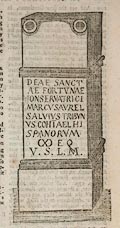




Mr URBAN,
I HAD the pleasure of yours in relation to the Altar I sent you, which was so much more necessary, as having procur'd Baron Clark's own Remarks on the Reading since I wrote to you. It may now be published, with the Conjectures of two of the best Antiquaries of the Age (the Baron and Mr Ward). I have drawn them up as below.


THIS remarkable ALTAR to FORTUNE was lately discover'd in ye outer Room of a Bath at Netherby, it being, as Baron Clark conjectures, a peculiar Ceremony in the Worship of that Goddess, to purify the Priest and the People with Water. That judicious Antiquary grounds his Opinion on a Yorkshire Altar, dedicated to the same Power; for which I refer you to Horsley's Brit. Romana, Page 304.
The Letters are very fair, but attended with considerable Difficulty in the Reading, by means of the peculiar Signature (X) at Bottom, which the Baron says was the ancient Manner of writing M; and indeed it appears to be so from Ol. Wormius's Runic Characters. See also Hick's Antiq. literat Septentr. He therefore assigns three various Readings to it as below.
DEAE * SANCTAE FORTUNAE CONSERVATRICI, MARCUS AURELIUS † FAVIUS TRIBUNUS ‡ COHORTIS PRIMAE AELIAE HISPANORUM
1. MILLE EQUITUM
2. MILLIARIA EQUITATA
3. CUM MILLE EQUITIBUS
VOTUM SOLVIT LUBENS MERITO.
Of these he prefers the two first, and chiefly the second.
Mr Ward thinks it should read MILLITUM EQUESTRIUM; and, if the Baron's first Method and this be right, what a Profusion of Criticism would have been sav'd to Salmasius, Lipsius, Caufabon &c. concerning equestrian Cohorts, had this signal Stone been discovered a few Centuries sooner! I know not but these Disputes about equestrian Cohorts might have also induced Mr Horsley to read the like Signature milliaria, or millenaria Cohors in a Durham Inscription in the Vardalorum Cranei (a Spanish People). See Brit. Rom. p.295. But as the Cohors milliaria seems to be a general Name for every first Cohort, I should rather prefer the mille equitum or militum equestrium, because the Cohors prima and milliaria appear to me one of them superfluous.
There is, if I mistake not, but one other Stone yet discovered that has a like Signature, and that is in the University of Glasgow, where it occurs four Times together on the same Altar, and must be there a Numeral. See Brit. Rom. p.197.
Mr Horsley conjectures that the Romans have made a Ligature of the direct and reverted C, connected with the Numeral X, for ten Hundred, or a Thousand, as thus (X) and so that Signature came in Use for mille; if so, it must admit of no other Reading but mille Equi-
† Falvius I read Alvius, there being no F in the Original.
‡ This Cohort was never known to have garrison'd Netherby before this Altar was discovered.

 tum:
tum:


 Gents Mag 1740 p.171
Gents Mag 1740 p.171